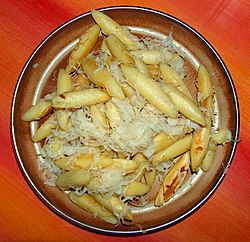Schupfnudel facts for kids

Schupfnudeln with sauerkraut
|
|
| Alternative names | Fingernudeln |
|---|---|
| Type | Dumpling |
| Place of origin | Germany, Austria |
| Main ingredients | Rye or wheat flour or potatoes, eggs |
Schupfnudel (say "SHOOP-f-noo-del") is a special kind of dumpling or thick noodle. People enjoy it in southern Germany and Austria. It's also known as Fingernudel, which means "finger noodle."
Schupfnudeln are often made from rye or wheat flour and eggs. Long ago, people started adding potatoes to the recipe. This happened after potatoes arrived in Germany in the 1600s. These tasty noodles get their unique oval shape from being rolled by hand. You can eat them as a savory dish, often with sauerkraut, or as a sweet treat!
Contents
How Schupfnudeln Were Developed
Schupfnudeln have a long history. They were known as a "trooper dish" during the Thirty Years' War. Soldiers would use their daily flour and water to make long noodles. Then, they would cook them.
After potatoes came to Germany in the 17th century, the recipe changed. Different areas started making their own versions. This led to many delicious types of Schupfnudeln we see today.
Names for Schupfnudeln in Different Places
You can find Schupfnudeln all over Germany. They are super popular in the Baden and Swabia regions. In these areas, people might also call them Baunzen or Bubenspitzle.
In Bavarian cuisine, they have many names. Some common ones are Fingernudeln (finger noodles) or Kartoffelbaunkerl (potato Baunkerl). In Upper Palatinate, they are called Schopperla or Schoppala.
If you visit the Odenwald area, you might hear them called Krautnudeln (cabbage noodles). In the Palatinate, they are known as Buwespitzle. The Bauchstecherla from Franconia are a bit thinner and more pointed.
There's also a sweet type called Mohnnudeln. These are made with poppy seeds and are popular in Bavaria and Austria.
Making Schupfnudeln: A Fun Process
The names Schupf- or Fingernudel describe how the noodle is made and its shape. The word Schupf means "to roll" or "to flatten" in some areas. There isn't just one way to make them. Many regions have their own special recipes!
Some people even argue about the "original" way to make Schupfnudeln. For example, a big German dictionary says they are fried. But a Bavarian dictionary says they are boiled in salty water. This shows how many different ways there are to enjoy them!
Simple recipes use only rye flour and water for the dough. But many recipes add mashed potatoes, wheat flour, and egg. First, the dough is mixed and kneaded. Then, it's rolled into a long, thin shape. This roll is cut into small pieces, about half an inch wide. Each piece is then rolled by hand into the classic Schupfnudel shape.
After shaping, they are either cooked in salty water for about ten minutes or deep-fried. Many recipes also suggest frying them in a pan afterward to make them extra crispy.
Schupfnudeln can be served in many yummy ways. For a savory dish, they might be served with sage butter or sauerkraut. For a sweet treat, they can be topped with poppy seeds, sugar, and cinnamon. Since the noodles themselves are quite plain, they soak up the flavors of whatever you serve them with. You can enjoy Schupfnudeln as a side dish or as the main meal.
At wine festivals in Baden and Swabia, you'll often find Schupfnudeln pan-fried with bacon bits and sauerkraut. In Swabia, some people like to eat them with cold fruits, like cold stewed apples or pears.
See also
 In Spanish: Schupfnudel para niños
In Spanish: Schupfnudel para niños

